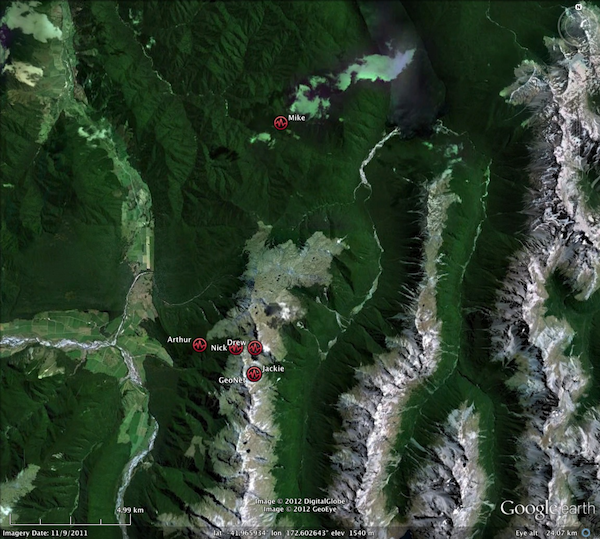2012 IRIS Workshop
Teaching Undergraduate Seismology with Spreadsheets and Global Earthquake Explorer (GEE)
Steven C. Jaume:College of Charleston
Earthquake locations for a January 28, 2012 M=4.5 earthquake in New Zealand determined by students (symbols with names) using earthquake location spreadsheet developed in the course versus the GeoNet catalog location. The majority of locations are within 2.5 kilometers of the GeoNet catalog location and one student (Jackie) matched the catalog location exactly.

Full-resolution graphics file in original format: 0081.jpg
During the Spring 2012 semester I experimented with using “near-real time” digital seismic data and spreadsheet exercises to teach an upper level undergraduate earthquake seismology course. Global Earthquake Explorer (GEE) was used to display and interpret SAC format seismic data, as well as retrieve and save “near-real time” seismograms. IRIS’s VASE (Viewing and Seismogram Extraction) and GeoNet’s CWB (Common Waveform Buffer) software were also used to retrieve additional data for course exercises. Seismic Analysis Code (SAC) was used to correct for instrument response where appropriate. A series of spreadsheets were developed that allowed students to input arrival times, amplitudes and P-wave first motions and determine earthquake locations, seismic wave speeds, crustal thicknesses, surface wave magnitudes and first motion focal mechanisms for recent earthquakes. Importantly, these spreadsheets were developed during the lecture period; i.e., students were shown how to input various equations (e.g., Spherical Law of Cosines) and use them in a problem-solving manner during the lecture period. These in-class exercises were followed up by outside assignments that used the concepts and spreadsheets developed in class. I found that while a smaller set of subject matter was covered as compared to a more traditional lecture style, students in the course reported greater satisfaction with the “data immersion” style of the course. Some problems encountered were occasional inability to reach seismic data servers and incompatibility of GEE with some older laptop computers owned by students. These issues were overcome by having a set of pre-selected seismograms ready for each section of the course and having working versions of GEE on all computers in our student computing room.
Acknoweldgements: I would like to thank Phil Crotwell (University of South Carolina) for maintaining Global Earthquake Explorer. Inspiration for updatable spreadsheets came from Introduction to Applied Geophysics (Burger et al., 2006). Stephen Boss’s (University of Arkansas) “Finding the Moho” lab activity was also used as inspiration for some class exercises.
For further reading: Burger, H. R., A. F. Sheehan and C. H. Jones (2006), Introduction to Applied Geophysics, W. W. Norton and Co., New York, N.Y.
Keywords: seismograms, spreadsheets, undergraduate_teaching
